Week 7-8. Structures and Textures of Metamorphic Rocks
Metamorphic Rock Textures Metamorphic rocks exhibit a variety of textures. These can range from textures similar to the original protolith at low grades of metamorphism, to textures that are purely produced during metamorphism and leave the rock with little resemblance to the original protolith. Textural features of metamorphic rocks have been discussed in the previous lecture. Here, we concentrate on the development of foliation, one of the most common purely metamorphic textures, and on the processes involved in forming compositional layering commonly observed in metamorphic rocks.
Foliation is defined as a pervasive planar structure that results from the nearly parallel alignment of sheet silicate minerals and/or compositional and mineralogical layering in the rock. Most foliation is caused by the preferred orientation of phylosilicates, like clay minerals, micas, and chlorite. Preferred orientation develops as a result of non-hydrostatic or differential stress acting on the rock (also called deviatoric stress). We here review the differences between hydrostatic and differential stress.
Stress and Preferred Orientation
Pressure increases with depth of burial, thus, both pressure and temperature will vary with depth in the Earth. Pressure is defined as a force acting equally from all directions. It is a type of stress, called hydrostatic stress or uniform stress. If the stress is not equal from all directions, then the stress is called a differential stress. Normally geologists talk about stress as compressional stress. Thus, if a differential stress is acting on the rock, the direction along which the maximum principal stress acts is called σ1, the minimum principal stress is called σ3, and the intermediate principal stress direction is called σ2. Note that extensional stress would act along the direction of minimum principal stress.

If differential stress is present during metamorphism, it can have a profound effect on the texture of the rock.
Rounded grains can become flattened in the direction of maximum compressional stress.

Minerals that crystallize or grow in the differential stress field may develop a preferred orientation. Sheet silicates and minerals that have an elongated habit will grow with their sheets or direction of elongation orientated perpendicular to the direction of maximum stress.
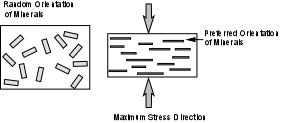
This is because growth of such minerals is easier along directions parallel to sheets, or along the direction of elongation and thus will grow along σ3 or σ2, perpendicular to σ1.
Since most phyllosilicates are aluminous minerals, aluminous (pelitic) rocks like shales, generally develop a foliation as the result of metamorphism in a differential stress field.Example - metamorphism of a shale (made up initially of clay minerals and quartz)
Shales have fissility that is caused by the preferred orientation of clay minerals with their {001} planes orientated parallel to bedding. Metamorphic petrologists and structural geologists refer to the original bedding surface as S0.
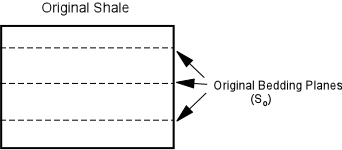
Slate Slates form at low metamorphic grade by the growth of fine grained chlorite and clay minerals. The preferred orientation of these sheet silicates causes the rock to easily break planes parallel to the sheet silicates, causing a slatey cleavage.Note that in the case shown here, the maximum principle stress is oriented at an angle to the original bedding planes so that the slatey cleavage develops at an angle to the original bedding. The foliation or surface produced by this deformation is referred to S1.
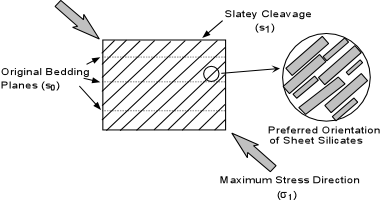
Schist - The size of the mineral grains tends to enlarge with increasing grade of metamorphism. Eventually the rock develops a near planar foliation caused by the preferred orientation of sheet silicates (mainly biotite and muscovite). Quartz and feldspar grains, however show no preferred orientation. The irregular planar foliation at this stage is called schistosity
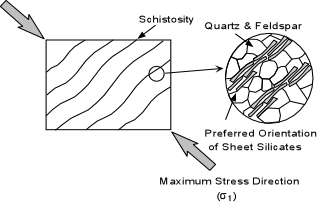
Gneiss As metamorphic grade increases, the sheet silicates become unstable and dark colored minerals like hornblende and pyroxene start to grow.These dark colored minerals tend to become segregated into distinct bands through the rock (this process is called metamorphic differentiation), giving the rock a gneissic banding. Because the dark colored minerals tend to form elongated crystals, rather than sheet- like crystals, they still have a preferred orientation with their long directions perpendicular to the maximum differential stress.
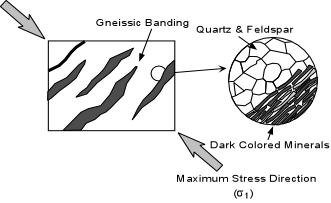
Granulite - At the highest grades of metamorphism most of the hydrous minerals and sheet silicates become unstable and thus there are few minerals present that would show a preferred orientation. The resulting rock will have a granulitic texture that is similar to a phaneritic texture in igneous rocks.

For detail see the Pdf file(Structures and Textures of Metamorphic Rocks)



